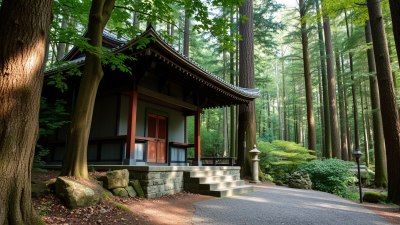The Sacred Quiet of Japan’s Forest Temples
Explore the serene beauty and spirituality of Japan's forest temples, where nature meets tranquility.

Image created with Flux Schnell
Japan is a land rich in culture and spirituality, where nature intertwines harmoniously with tradition. Among the many treasures of this unique nation are its forest temples, sacred spaces that evoke a deep sense of peace and connection to the natural world. These temples, often hidden away in the lush forests that blanket the country, provide refuge from the fast-paced life of modern society. In this article, we will delve into the tranquil beauty of Japan's forest temples, exploring their origins, architectural features, and the experiences they offer visitors.
Historical Significance of Forest Temples
The roots of forest temples in Japan can be traced back to ancient times, reflecting the country's deep spiritual heritage influenced by Shintoism and Buddhism. Forests are considered sacred spaces in Japanese culture, believed to be inhabited by spirits and deities. As such, many temples were built within these natural sanctuaries to create a direct connection between the divine and the earthly realms. The secluded settings of these temples allowed for meditation and reflection, fostering a sense of spiritual renewal and enlightenment.
Architecture and Design
The architecture of Japan's forest temples is a testament to the ingenuity and aesthetic sensibilities of ancient craftsmen. These structures blend seamlessly with their natural surroundings, often constructed from locally sourced materials like wood and stone. The designs emphasize simplicity and harmony, with the buildings often featuring sloped roofs that mimic the surrounding landscape. The use of shoji screens and paper lanterns creates a soft, gentle light within the temple, enhancing the tranquil atmosphere.
The Role of Nature
In forest temples, nature plays a vital role in the overall experience. The serene environment surrounding each temple not only provides a backdrop for spiritual practices but also serves as a living entity that enhances the meditative atmosphere. Tall trees, vibrant greenery, and the sounds of rustling leaves or flowing water contribute to an immersive experience that calms the mind and elevates the spirit. Visitors often find that spending time in these settings fosters a deep sense of introspection and peace.
Popular Forest Temples to Visit
While many forest temples remain lesser-known, several stand out due to their historical significance and breathtaking locations. One such temple is the famous Kinkaku-ji, or the Golden Pavilion, nestled in the tranquil surrounds of Kyoto. This stunning Zen temple is surrounded by lush gardens and reflects beautifully on the adjacent pond. The temple's golden exterior glistens in the sunlight, creating a surreal and calming presence amidst the forest.
Another notable temple is the Tenryu-ji, also located in Kyoto. This UNESCO World Heritage Site is renowned for its beautiful gardens and its placement at the foot of the Arashiyama mountains. The temple's design incorporates nature into its layout, allowing visitors to enjoy stunning views and peaceful walks through the surrounding forest, further enhancing the spiritual experience.
In the northern region of Japan, one can find the sacred Hiraizumi temples, which include the famous Chuson-ji temple. Set within a tranquil forest, this temple complex is rich in history and offers a glimpse into the Heian period's cultural and religious practices. The serene landscape invites contemplation and reflection, providing a perfect escape from the hustle and bustle of everyday life.
The Experience of Visiting a Forest Temple
Visiting a forest temple is more than just a sightseeing activity; it is an experience that engages the senses. As you approach the temple, the gentle rustling of leaves and the subtle fragrance of pine fill the air, creating an atmosphere of serenity. Walking along the pathways, one can appreciate the intricate details of the temple's design, from the delicate carvings to the peaceful gardens that invite quiet reflection.
Many visitors engage in traditional practices during their visit, such as lighting incense, offering prayers, and partaking in meditation. These rituals allow individuals to connect with their spirituality and find solace in the stillness of the forest. The act of sitting quietly in the midst of nature fosters a deeper understanding of oneself and cultivates a spirit of gratitude for the beauty surrounding us.
Seasonal Changes and Their Impact
The beauty of Japan's forest temples is further accentuated by the changing seasons. In spring, cherry blossoms bloom, creating a picturesque scene as delicate pink petals dance in the gentle breeze. Summer brings vibrant greenery and a chorus of chirping insects, while autumn paints the forests in hues of red and gold, giving the temples a magical ambiance. Winter, with its serene snow-covered landscapes, transforms the temples into ethereal sanctuaries, providing a space for quiet contemplation during the cold months.
Eco-Spirituality and Conservation Efforts
In recent years, there has been a growing sense of eco-spirituality among visitors to Japan's forest temples. Many people recognize the importance of preserving these sacred spaces and their natural surroundings for future generations. Conservation efforts are underway to protect the delicate ecosystems that thrive in these areas, ensuring that the beauty and tranquility of the temples remain intact.
Visitors are encouraged to practice responsible tourism by respecting the natural environment and minimizing their impact during their visits. By embracing eco-friendly practices, we can contribute to the preservation of these sacred spaces and ensure that the harmony between nature and spirituality continues to flourish.
The Future of Japan's Forest Temples
As modern life becomes increasingly hectic, the allure of Japan's forest temples remains strong. They continue to serve as sanctuaries for those seeking peace and spiritual renewal. With the rise of mindfulness and wellness practices, these temples offer a unique opportunity for individuals to disconnect from the chaos of daily life and reconnect with nature and themselves.
In the future, it is essential to continue promoting the significance of these sacred spaces, not only as places of worship but also as vital components of Japan’s cultural heritage. By raising awareness and fostering a deeper appreciation for their historical, spiritual, and ecological value, we can ensure that the tranquility of Japan's forest temples endures for years to come.
The sacred quiet of Japan’s forest temples offers a restorative experience that transcends time and space. With their intricate designs, tranquil settings, and deep spiritual significance, these temples continue to capture the hearts of visitors from around the world. Whether you seek solitude, spiritual connection, or simply an appreciation of nature's beauty, these sacred spaces invite you to pause, reflect, and find solace in the gentle embrace of the forest.











